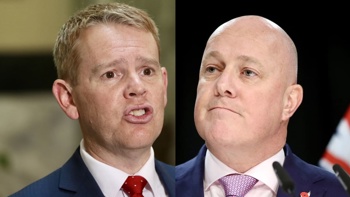With school starting next week, it’s time for parents and kids to get organised – and the Herald is here to help. Today Georgina Campbell looks at uniforms.
Christchurch mum Stacy Holdaway saved $300 over the summer to buy a school uniform for her daughter who is starting intermediate this year - and that’s just for secondhand items.
A new girls’ uniform for Casebrook Intermediate School, where 11-year-old Starfire is going, costs about $500, according to the Mainland Uniforms website.
That includes a jersey, two blouses, a skirt, a jacket, shoes, socks, tights, and a bucket hat. These costs do not include the physical education uniform.
Holdaway planned to go to the school’s second-hand uniform sale to save money. She hoped she could buy everything she needed for $200 but wanted to have $300 saved to be on the safe side.
“You have to have uniforms so it’s just one of those things ... I don’t really muck around with Facebook or anything like that, or Trademe, because I know if I go to the second-hand sale, I’m going to get something.”
/cloudfront-ap-southeast-2.images.arcpublishing.com/nzme/XVXYAAI6UNA2ZESSDFBQISHYBE.jpg)
Stacy Holdaway with her children Starfire Mair and Korin Mair and husband Tim Holdaway. Photo / George Heard
Holdaway said it would probably be easier for Starfire not to have a uniform and wear the clothes she already had to school.
“Other clothes - you can get them so easily. It doesn’t matter if they go through a pair of pants because you can always nip out to the op shop and buy them another two pairs of pants for $5.“
However, she also acknowledged the benefits of having a uniform.
“It’s nice that no one can make fun of anyone else for what they’re wearing ... but the expenses are a bit of a nightmare.”
Top tips for saving money on uniforms
While Holdaway preferred to go to her daughter’s school uniform sale, many parents do find buy-and-sell Facebook pages helpful to score a bargain.
Other schools have second-hand uniform shops and some parents choose to buy more expensive items, like a blazer, a size or two too big so that children can grow into them.
There are schemes available to help parents save for uniforms. NZ Uniforms, which stocks uniforms for many schools across the country, has a uniform club card that parents can slowly top up throughout the year to lighten the load at the start of the school year.
Club members also receive 10 per cent off items like shoes and school bags.
NZ Uniforms chief executive David Bunnell said the company employed more than 150 students over and above the regular number of team members to assist in-store during January.
Bunnell acknowledged there was a strong second-hand market for families.
“The great thing about quality school uniforms is that they are built to last and contribute to the circular economy where they are often passed down to several members of the same family or sold and gifted when they are outgrown.”
Ministry of Education operations and integration leader Sean Teddy said it was important there were no barriers to accessing education, including the cost of uniforms.
“We know many schools are conscious of the costs and actively seek ways to minimise these costs and they support parents in a number of ways. For example, some schools have unbranded uniforms so parents can shop around for a variety of lower-cost clothing and shoe options.
“Other schools have free/pre-loved uniforms widely available to whānau/parents. Other schools stagger payments for school uniforms and help to put families in touch with other organisations that can help.”
Where should parents raise concerns about uniform requirements?
Teddy said the ultimate decision on uniforms rested with school boards which meant there were a variety of approaches to dress codes in New Zealand.
“We expect that when schools are considering uniform options, they consult with their parent community before making decisions,” Teddy said.
“It is also our expectation that schools should not make significant profits from the sale of school uniforms.”
Parents with any concerns about uniform requirements, including the cost, should formally raise these with the school board.
What to do if parents can’t afford a school uniform
Children’s charity Variety helps thousands of families in New Zealand through a scheme where Kiwis can sponsor a child in need for $50 per month.
Caregivers can use this money to pay for essentials, including uniforms, and Variety pays suppliers directly.
This year the charity processed almost 1700 claims for school uniforms which made up 15 per cent of all claims.
Variety chief executive Susan Glasgow said some families were facing the reality of prioritising putting food on the table or paying for uniforms.
Anxiety could set in when children don’t have what they need to start the school year, she said.
“I think families feel real shame in having to ask for support and help. Whakamā is what we talk about - that sense of shame going to school, not being like their friends, feeling ‘othered’ because they simply don’t have the right uniform or their shoes don’t fit or they don’t have shoes.”
Glasgow knew of a father living in transitional housing in Auckland who was being forced to move for the third time in one year, meaning his children would have to move schools again.
“Buying one uniform is expensive, having to buy three different uniforms in a year, it’s cost prohibitive ... those things are beyond their control, you can’t help the fact you’re being moved and your children need to go to different schools.”
Ministry of Social Development client services delivery general manager Jayne Russell said parents and caregivers on low incomes could apply for hardship assistance for uniforms and they don’t have to be on a benefit to qualify.
This money does have to be paid back but repayments can be set at a manageable level, Russell said.
“We may discuss ways to minimise school uniform costs, such as looking at second-hand options. Sometimes staff may require receipts or quotes in order to approve costs such as if the requested amount exceeds the recommended guidelines.
“We can also put people in touch with budgeting services to help them prepare for expenses, such as school costs.”
If someone is receiving an Orphan’s or Unsupported Child Benefit they can apply for the School and Year Start-Up Payment, which does not have to be paid back.
Take your Radio, Podcasts and Music with you









